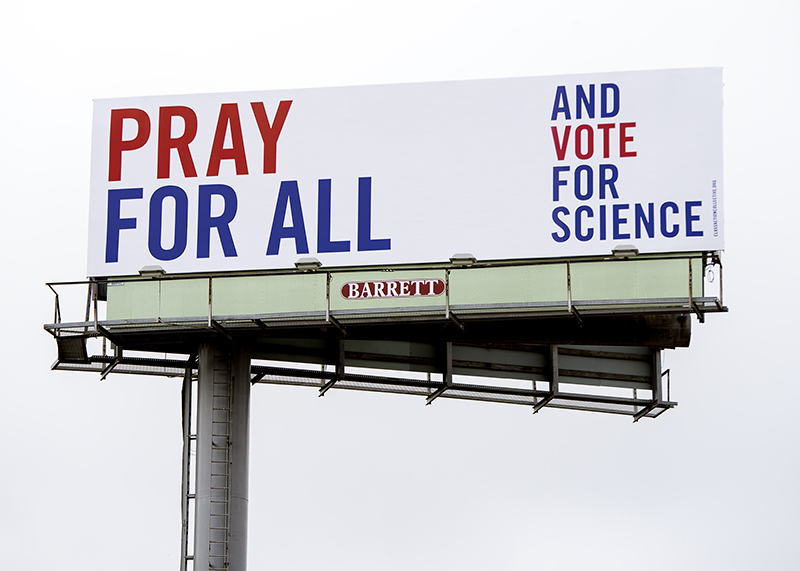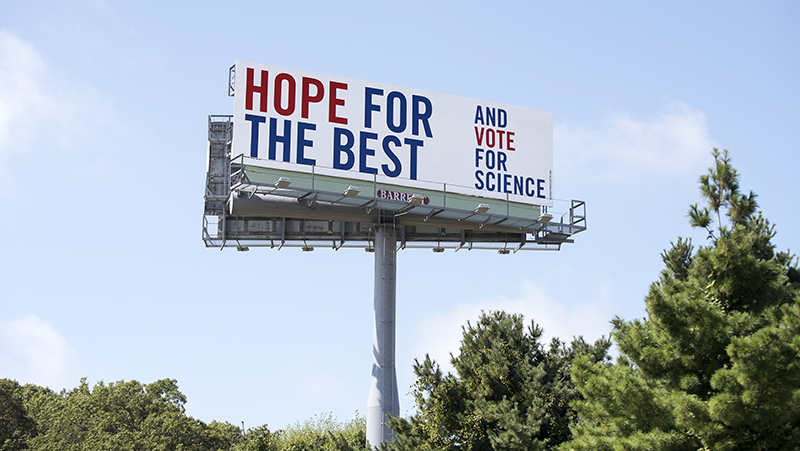
A group of designers known as the Class Action Collective have installed three provocative billboards on Interstate 95 between Boston and New York City, one of the nation’s busiest highways. The public art project confronts the current administration’s policies that have sidelined science and urges American citizens to take action by voting for pro-science candidates in the upcoming elections. This public art project is supported by a grant from the Union of Concerned Scientists, through its Art for Science Rising program. The UCS conducted a national search for “public-facing art that highlights the role science plays in protecting our health and safety, and the critical role we all play in ensuring that science isn’t sidelined.” Pamela Worth from the Union of Concerned Scientists reached out to the Collective to learn more about their project.
Pamela Worth: Can you describe the background and genesis of the Class Action Collective?
Class Action Collective: The design profession traditionally operates on client commissions and thus, design is often a process of giving form to other people’s words and ideas. We met in grad school and all took an elective class about designing in response to current social and political issues. In this class, we were tasked with articulating our own position as the basis for the work, merging the impetus of fine artists with the methodology of designers. A group of students from the initial class founded the collective in 1992. Additional members came from the classes taught in 1993 and 1994. Each of the three classes is represented in the five of us that currently comprise Class Action. Like designers, we work from concerns about language, audience and format. Like artists, we are in full control of, and take full responsibility for, the content and form of our work. All of us have been engaged in visual activism as a collective, as individuals and as educators.
PW: Why was the collective motivated to apply for this particular grant?
CAC: Designers are skilled at making messages legitimate through visual and verbal hyperbole. So we were motivated by the opportunity to attract and engage viewers, to alert them to their civic role in supporting science. We in Class Action all share a similar view about how truth and fact are in jeopardy in the current political discourse. This is particularly frightening to us when it comes to crucial scientific information, for example the denial of climate change. Until the present administration, no one thought that “alternative facts” existed. Now, simply by inserting this into the public discourse, some surely have been convinced that they do. Pure propaganda. Acting as citizen designers, we sought to create our own counter-propaganda.
Designers are skilled at making messages legitimate through visual and verbal hyperbole.
PW: What is the significance to you of locating your project on route 95?
CAC: We sought a highly public venue that would have the potential to touch a large number of viewers of many different mindsets. The project was a perfect fit with Barrett Outdoor, a company with many billboards on this well-traveled route between Boston and New York City and who have been supporters of our work to utilize the power of the billboard medium for important civic messages. Our messages will be seen by literally millions of viewers. We will also pursue sites in other cities.
PW: I find the billboards bold and clever! What do you hope others will take away from your work?
CAC: Bold is good! We were determined to create a simple but impactful design to stand out in the environment. We want people’s commutes to be interrupted for a few moments to cause them to pause and think more deeply about the enigmatic messages conveyed. Many people take the validity and importance of science for granted. We hope our messages remind both these Americans, as well as those who may have come under the influence of a factless and truthless web being spun by the current administration, that candidates in the upcoming elections should be considered on their outright support and affirmation of scientific facts as the basis for decision-making. That is a critical qualification for election.

PW: How did you come up with such powerful messages using such pithy text?
CAC: We began with the concept of reminding viewers of the everyday benefits of science that we all enjoy, like medicines, eyeglasses, or GPS but we soon moved onto concepts that cover more ground in part by requiring viewers to connect the dots themselves. We also considered folk sayings that are familiar and express a generally accepted truth based on common sense that would be recognized by all people.
Billboards viewed from fast-moving vehicles are constrained by short reading times. Messages have to be brief, but science warrants something more substantive than a slogan. We were attracted to aphorisms and proverbs as they condense a lot of meaning into a few words. The most memorable aphorisms unite two sides of the same concept. As we continued working on proverbs and other forms of language we found ourselves coming back to this form.
PW: What does “vote for science” mean to you?
CAC: It means considering the implication of candidates who deny science—what will they base their decision-making power on, if not rigorous research and facts? Suddenly this becomes a question to ask of candidates where previously it was a given that a candidate would have a rational relationship with science.
PW: How do you think can art make positive change on science-based issues?
CAC: What art can do is provide a completely new and different perspective that leads to insights and understanding. Taking people by surprise, through a medium or venue that is unexpected, allows the message to get through before any defenses might come into play. By reaching people in a public environment, perhaps the message has a better chance of acceptance than a political argument would, for example. Also, aren’t art and science the most important catalysts for progress in a society?

PW: Why do you personally feel science is important to our democracy/decision-making processes?
CAC: The scientific method is a fact-based method. If we put our trust in elected officials to make important decisions and they do so without the rigor of science, they will not be able to serve our country in any reliable way. As a result, our personal and collective futures are impacted. We are no longer forward-thinking and forward-acting. If an elected official’s decisions are not based on scientific evidence, they are merely personal opinions tainted by political agendas.
PW: Do you think other billboard companies will pick up this series?
CAC: We certainly hope so. Outdoor advertising companies enjoy the position of quite literally communicating with the people in a public forum. Billboards last a short time and thus can speak to important matters of the moment. There will most likely be a great deal of billboard messaging in this election season. Billboard companies can play an important role in engaging viewers in civic matters.
PW: The billboards made me think of the passage in the Bible where Jesus says, “Render unto Caesar that which is Caesar’s, and unto God that which is God’s.” Are you aiming to convey that science and faith can and should coexist?
CAC: Yes, and indeed they have coexisted in modern times until recently. We should be reminded that it was a Catholic president who took us to the moon. Secularized versions of the God/Ceasar quote are common beyond the bible, for example, “Cleanliness is next to godliness,” or “God helps those who help themselves.” One of the earliest examples of aphorisms we found encouraged putting one’s trust in God, but at the same time accepting responsibility for our earthly acts. We were attracted to this spiritual world/physical world duality. As for deciding the exact phrases each billboard would begin with, we sought generally accepted sayings that transcend specific religions and that are familiar and inviting.
Editor’s Note: The billboards have been “adopted” by the “For Freedoms Initiative” — an ambitious project going on through election day all across the country. “Building off of the existing artistic infrastructure in the United States, For Freedoms has developed a network of artists and institutional partners who will produce nationwide public art installations, exhibitions and local community dialogues in order to inject nuanced, artistic thinking into public discourse.“
Editor’s Note: The billboards have been “adopted” by the “For Freedoms Initiative” — an ambitious project going on through election day all across the country. “Building off of the existing artistic infrastructure in the United States, For Freedoms has developed a network of artists and institutional partners who will produce nationwide public art installations, exhibitions and local community dialogues in order to inject nuanced, artistic thinking into public discourse.“
